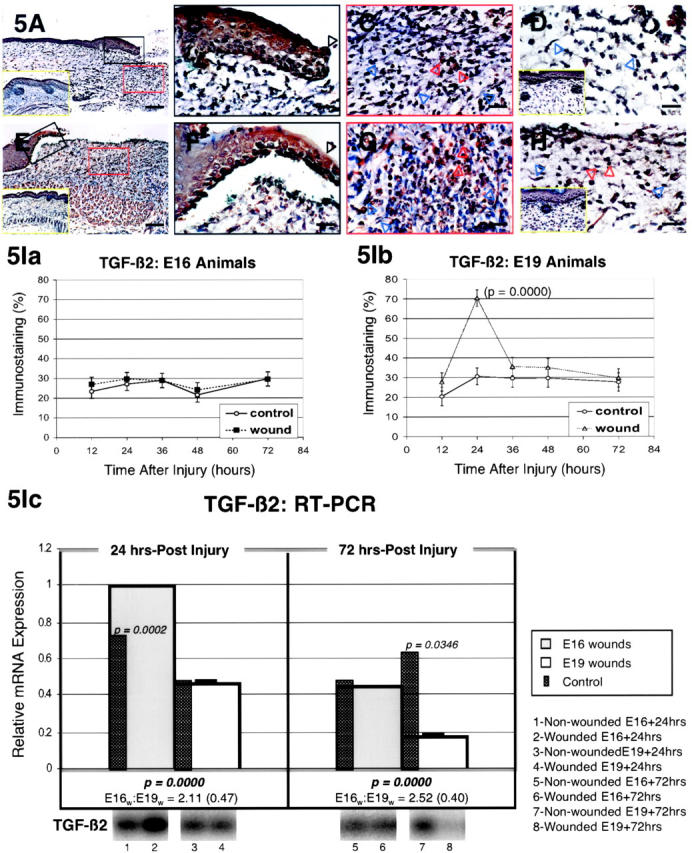Figure 5.

TGF-β2 immunostaining of wounded E16 and E19 rat skin. A: E16 skin, 24 hours post-injury; magnification, ×100. Up-regulated TGF-β2 expression is primarily present in epidermal cells and in dermal inflammatory cells. Non-wounded E17 [ie, E16 + 24 hours] control skin is also shown (inset, A, yellow rectangle). B: E16 skin, 24 hours post-injury; magnification, ×400. Strong TGF-β2 staining is present in outer and basal epidermal layers in addition to the migrating epidermis (black open arrow) after injury. C: E16 skin, 24 hours post-injury; magnification, ×400. Inflammatory cells (red open arrows) stain moderately for TGF-β2, while fibroblasts demonstrate minimal (blue open arrows) and ECM exhibit no TGF-β2 staining. D: E16 skin, 36 hours post-injury; magnification, ×400. Minimal TGF-β2 staining that is not significantly different from control is noted in fibroblasts (blue open arrows) and the ECM. Non-wounded E17.5 [ie, E16 + 36 hours] control skin is also shown (inset, D, yellow rectangle). E: E19 skin, 24 hours post-injury; magnification, ×100. Increased epidermal and dermal TGF-β2 localization relative to control skin are noted. Non-wounded E20 [ie, E19 + 24 hours] control skin is also shown (inset, E, yellow rectangle). F: E19 skin, 24 hours post-injury; magnification, ×400. Moderate TGF-β2 staining is present in outer and basal epidermal layers in addition to the migrating epidermis (black open arrow). G: E19 skin, 24 hours post-injury; magnification, ×400. Inflammatory cells (red open arrows), fibroblasts (blue open arrows), and ECM TGF-β2 expression are all increased to moderate levels after injury. H: E19 skin, 36 hours post-injury; magnification, ×400. Wounded E19 skin demonstrate persistent inflammatory cell TGF-β2 staining 36 hours after injury (red open arrows) whereas minimal TGF-β2 staining is observed in fibroblasts (blue open arrows) and the ECM. Non-wounded, E20.5 [ie, E19 + 36 hours] control skin (inset, H, yellow rectangle) exhibit minimal dermal TGF-β2 staining. Bars: A and E, 200 μm; B–D, F–H, 50 μm. I. Computerized quantitation of dermal TGF-β2 immunostaining in E16- and E19-wounded fetuses. Ia: Dermal TGF-β2 staining does not increase significantly in wounded E16 animals at any of the time points studied (P >0.05). Ib: In contrast, dermal TGF-β2 staining increases significantly in E19 animals 24 hours after wounding relative to non-wounded controls (P = 0.0000). Ic: RT-PCR of TGF-β2. Please refer to the Figure 4Ic ▶ legend for an explanation of the bar graphs and representative Southern blot data.
